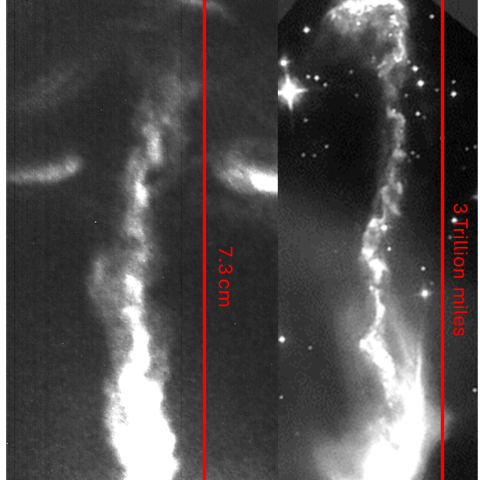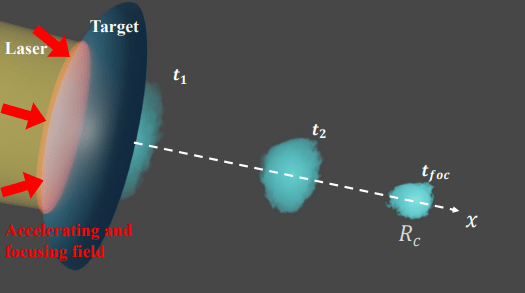Research supporting MACH, Magnetic Acceleration Compression and Heating an NNSA Center of Excellence
The principal objective of our support for MACH is to improve the understanding of the physics of HED plasma through high quality experimental research, computer simulations, and theory. Our goals include advancing the capability of HED science in the United States and the training the next generation of HED research scientists for stockpile stewardship and other programs of importance to national security. We are interested in the application of magnetized HED plasmas to inertial fusion energy and intense radiation generation and the understanding of observed high energy astrophysical phenomena. To achieve these objectives, we operate two pulsed power machines with a state-of-the-art suite of diagnostics. With these machines, our staff and graduate students at Cornell design and carry out world class magnetized HED plasma experimental research. This includes the study of x-pinches, gas-puff z pinches, plasma turbulence and novel z-pinch geometries. We also develop advanced computer simulations and analytic theory to help understand the experiments. Where necessary, we develop our own diagnostics that include Thomson scattering, visible and X-ray spectroscopy, Faraday rotation and Zeemann splitting for measuring magnetic fields and an imaging refractrometer for observing plasma turbulence.
Because of the extensive pulsed power and diagnostic capabilities at Cornell, time in our laboratory is made available to the other MACH Center partners for their experimental and computational work.
To achieve these objectives, we operate two pulsed power machines with a state-of-the-art suite of diagnostics. With these machines, our staff and graduate students at Cornell design and carry out world class magnetized HED plasma experimental research. This includes the study of x-pinches, gas-puff z pinches, plasma turbulence and novel z-pinch geometries. We also develop advanced computer simulations and analytic theory to help understand the experiments. Where necessary, we develop our own diagnostics that include Thomson scattering, visible and X-ray spectroscopy, Faraday rotation and Zeemann splitting for measuring magnetic fields and an imaging refractrometer for observing plasma turbulence.
Because of the extensive pulsed power and diagnostic capabilities at Cornell, time in our laboratory is made available to the other MACH Center partners for their experimental and computational work.
Laboratory Astrophysical Plasma Jets
 We have studied two types of plasma jets. The first type, precursor jets, are basically hydrodynamic in nature and form from ablating radial foils (or wires) with and without an applied axial magnetic field. With an applied magnetic field, the jets and ablated plasma above the foil were observed to rotate. Due to the reproducibility of these precursor jets, they provide an excellent testbed for developing Thomson scattering and other diagnostics but are not particularly relevant to astrophysical jets. Later, as the radial foil ablates fully, a second jet forms which carries a significant amount of current. These magnetically driven jets mimic the magnetic tower model of astrophysical jet formation; however, they form very late in the current pulse and are unstable to current-driven kink instabilities beyond a length of about 1 cm. Recently, a new platform has been developed which replaces the radial foil with azimuthally symmetric gas-puff injection. This provides a continuous mass source and enables free rotation of the jet foot points. Furthermore, because there is no ablation phase, the magnetically driven jets develop at the beginning of the current pulse and can be driven longer without depleting their mass source and disrupting. The resulting free-boundary, high aspect ratio (>50:1) plasma jets remain stable for hundreds of nanoseconds and achieve lengths >5 cm. The jets strongly resemble naturally occurring astrophysical jets and experimental measurements reveal that they satisfy MHD scaling relations for protostellar jets in particular. Prominent helical and double helical features are observed, suggesting the jets may self-organize into stable configurations characterized by force-free currents flowing along the magnetic field lines. Strong helical shear flows have also been measured, which may account for the enhanced stability of the jet at large aspect ratios..
We have studied two types of plasma jets. The first type, precursor jets, are basically hydrodynamic in nature and form from ablating radial foils (or wires) with and without an applied axial magnetic field. With an applied magnetic field, the jets and ablated plasma above the foil were observed to rotate. Due to the reproducibility of these precursor jets, they provide an excellent testbed for developing Thomson scattering and other diagnostics but are not particularly relevant to astrophysical jets. Later, as the radial foil ablates fully, a second jet forms which carries a significant amount of current. These magnetically driven jets mimic the magnetic tower model of astrophysical jet formation; however, they form very late in the current pulse and are unstable to current-driven kink instabilities beyond a length of about 1 cm. Recently, a new platform has been developed which replaces the radial foil with azimuthally symmetric gas-puff injection. This provides a continuous mass source and enables free rotation of the jet foot points. Furthermore, because there is no ablation phase, the magnetically driven jets develop at the beginning of the current pulse and can be driven longer without depleting their mass source and disrupting. The resulting free-boundary, high aspect ratio (>50:1) plasma jets remain stable for hundreds of nanoseconds and achieve lengths >5 cm. The jets strongly resemble naturally occurring astrophysical jets and experimental measurements reveal that they satisfy MHD scaling relations for protostellar jets in particular. Prominent helical and double helical features are observed, suggesting the jets may self-organize into stable configurations characterized by force-free currents flowing along the magnetic field lines. Strong helical shear flows have also been measured, which may account for the enhanced stability of the jet at large aspect ratios..
Power Flow Problems in Pulsed Power Machines
These studies investigate the behavior of realistic (multi-use) electrodes in the power flow of next generation pulsed power systems where materials will be subject to intense current densities, electric fields and radiation effects. This is a new program for LPS with more input on this Web Site as this study progresses.Laser Propagation through Turbulent Plasma
This is also a new program for LPS and will investigate how laser beams propagate through highly perturbed/turbulent plasmas and hypersonic boundary layers. This study will provide new, quantitative information for laser-based communication systems and potential laser-based early warning defense systems. An imaging refractometer system is used to provide direct measurements of the effects of any small-scale disturbances of a plasma flow on a propagating beam. This is supplemented with Thomson scattering based measurements of density and velocity fluctuations from widening of the ion acoustic and electron plasma wave spectra alongside measurements of the bulk temperature, density, velocity and ionization state of the plasma.Ultra-intense laser-plasma interactions for inertial fusion energy and advanced accelerators
Investigations of the interactions of ultra-intense laser pulses with gaseous and solid-density plasmas – theoretically, experimentally, and computationally – form another major research thrust of LPS funded by the National Science Foundation, Department of Energy, Office of Naval Research, and the Air Force Office of Scientific Research. Present research concentrates on the following areas:- Laser-plasma accelerators of electrons, with applications to x-ray generation, development of future compact lepton colliders, and the development of medically-relevant compact accelerators for Very High Energy Electron (VHEE) radiation therapy.

Schematic of electron injection into an EPUB driven by (a) linearly polarized laser pulse and (b) circularly polarized laser pulse. An expanding and transversely undulating bubble (early time: light blue, later time: dark blue, bubble back motion: green arrows) is formed by a laser with steepened front (intensity in red). According to laser polarization, periodically modulated or flat current beam (bunch density in yellow) can be generated. The graphs in the bottom with the white axes show injected current profiles (yellow lines). - Interactions of petawatt-scale ultra-short laser pulses with solid-density targets and ion acceleration, with applications to Ion Fast Ignition of fusion capsules, ion-driven inertial fusion energy, and compact accelerators for ion-based cancer therapy.

CLIA Schematics. A Circularly polarized laser (yellow) is incident on an overdense target with front side shaped like a paraboloid (dark blue), generating a accelerating and focusing field (red), accelerating and focusing (red thick arrows) a quasi-neutral plasma beam. After the initial acceleration, the beam propagates ballistically, forming a high flux ion beam at well defined focal length simultaneously. - Interaction of laser pulses with nanostructured targets that result in the generation of highly-localized dense electron-hole plasmas, with applications to high-harmonics generation in solids, laser nano-machining, and the development of exotic targets for x-ray generation and ion acceleration.
